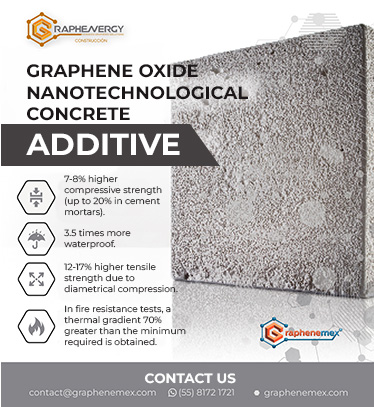Overcoming Construction Challenges:
Graphene Oxide Additives Minimize Thermal Cracking
In concrete, the binding agents are mainly a combination of pozzolanic materials and cement that, during the hydration process, releases heat accompanied by volumetric changes. This phenomenon in the presence of elements with low thermal dissipation prevents heat from diffusing efficiently, resulting in a temperature gradient between the outer surface and the inner core. That is, the temperature on the surface of the mixture usually cools faster, but inside it, the temperature rises gradually. This non-uniformity in heat distribution can generate large tensile stresses responsible for the well-known thermal cracking of concrete.
Current strategies to reduce such thermal stresses include placement of cooling pipes, use of low-heat Portland cement, phase change materials, polymeric fibers, or surface insulation. However, little attention is paid to improving the spread of heat in the cement itself. In this sense, and since cement is a nanostructured material due to the content of C-S-H nanoparticles, it is not uncommon for the nanoscale to be one of the most innovative trends in modern civil engineering, since it has been proven that most of the affectations of concrete, as thermal cracking, originate from different chemical and mechanical factors of the cement structure, the main concrete binder.
Graphene oxide (GO) is an oxidized version of Graphene, the nanomaterial that over the past decade has been the focus of numerous industries, including the construction industry. Both nanostructures are a single sheet of densely organized carbon atoms that provide numerous mechanical, thermal, and electrical properties, among others.
GO, unlike Graphene, contains a large number of oxygenated groups of the epoxide (C-O-C), hydroxyl (-OH) and carboxyl (-COOH) type that make it, on the one hand, a material that is easily dispersible in water and, on the other , give it the ability to interact with the C-S-H nanoparticles of the cement to transfer its properties and improve its performance and durability from the micro and nano scale.
Thermal conductivity
The thermal conductivity of GO depending on the degree of oxidation can reach 670 W/ (m K), while the conductivity of copper and aluminum is approximately 384 and 180 W/ (m K), respectively. This means that GO can conduct heat more efficiently than metals. However, transferring this property to other materials is not an easy task, for which it is important to overcome three main challenges:
i) Have extensive scientific knowledge of graphene materials, if possible, from their synthesis or production,
ii) Control the quality of the mix design and,
iii) Have a comprehensive vision, both technical and scientific, for the proper use and distribution of GO nanoparticles with cement to achieve the objectives set.

Graphenergy Construcción® is a water-based multipurpose additive with a specialized formula based on graphene oxide that favors the cement hydration process, not only acting as a promoter for the formation of a network of C-S-H crystals responsible for the densification and resistance of concrete, but also improves the thermal conductivity during its hydration and setting.
During the hydration of the cement, an exothermic reaction occurs, that is, heat is released, which is also accompanied by volume changes. When this heat is not dissipated efficiently, large tensile stresses can be generated, that are responsible for the well-known thermal cracking of concrete.
The crystalline network of the GO structure allows it to dissipate heat with great efficiency and even withstand intense electrical currents without heating up.
In the case of fresh concrete mixes, Graphenergy Construcción® promotes a more homogeneous heat distribution, minimizing the temperature gradient and volumetric changes, thus reducing the probability of thermal cracking.
In the case of hardened concrete, and even though it is an insulating material, when it is exposed to temperatures close to 400°C, its mechanical resistance is significantly compromised. The use of Graphenergy Construcción® reduces this risk, since it has been proven that its application generates a temperature difference 70% lower than the parameter required by the test between the exposed surface and the surface not exposed to fire.
Therefore, the contribution of the GO nanonetwork present in Graphenergy Construcción® helps to homogeneously distribute the hydration and setting temperature, reduces the risk of thermal cracking, increases the resistance of concrete at high temperatures and, finally, offers an excellent option sustainable for energy savings, particularly for those buildings whose geographical location requires the use of air conditioning equipment, achieving temperature reductions of up to 3 °C inside the buildings.
Drafting: EF/DHS
References
- Tanvir S., et al. Nano reinforced cement paste composite with functionalized graphene and pristine graphene nanoplatelets. Compos. B. Eng. 2020; 197: 15, 108063,
- Dong Lu., et al. Nano-engineering the interfacial transition zone in cement composites with graphene oxide. Constr. Build. Mater. 2022; 356: 129284,
- Peng Zhang., et al. A review on properties of cement-based composites doped with Graphene. J. Build. Eng. 2023: 70, 106367,
- WANG Qin et al., Research progress on the effect of graphene oxide on the properties of cement-based composites. New Carbon Mater. 2021; 36: 4,
- Junjie Chen, Effect of oxidation degree on the thermal properties of graphene oxide. j mater rest technol. 2020; 9:13740,
- Karthik Chintalapudi. The effects of Graphene Oxide addition on hydration process, crystal shapes, and microstructural transformation of Ordinary Portland Cement. J. Build. Eng. 2020; 32, 101551,
- Guojian Jing et al., Introducing reduced graphene oxide to enhance the thermal properties of cement composites. Cem Concr Compos. 2020; 109, 103559,
- Jinwoo An et al., Edge-oxidized graphene oxide (EOGO) in cement composites: Cement hydration and microstructure. Compos. B. Eng. 2019; 173, 106795

























